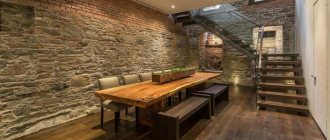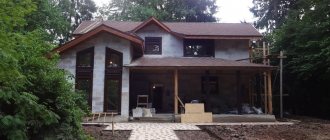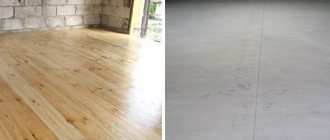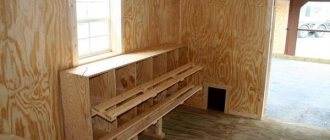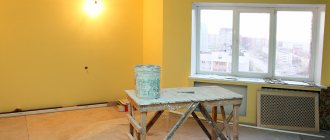To begin with, it is worth distinguishing between the concepts of basement, cellar and ground floor. The first room is part of the foundation; it is completely below ground level and is often adapted for the placement of communications. The ground floor is also called the “semi-basement”. This is a special room that rests on a foundation and is only partially buried in the soil. It is often equipped for garages and storage rooms. A cellar (underfloor) can be either a separately constructed building or the basement itself. It is usually used to store household equipment, preparations and vegetables for the winter. Basements have no windows, no natural light enters them, and thanks to the thermal insulation properties of the soil, the same temperature is maintained at any time of the year. After construction, they are rarely finished; they are left in rough form, since unnecessary work is associated with additional expenses. In many private houses, basements occupy an impressive area, which sooner or later the owners think about converting. As you know, nothing is impossible, so let’s find out in detail what work needs to be done to “domesticate” this room.
Key points in finishing the basement of a private house
Almost every second private house is equipped with a basement.
Many people leave it as a utility room, garage or cellar, without thinking that it contains additional square meters that can be beneficial. With a little imagination, a nice basement design, you can turn it into a spacious and functional room. Which one? The choice is yours.
Modern mini-productions
The history of Russian mini-productions started back in the 80s of the last century. This business sector went through several stages of development before massive digitalization and technology turned it into one of the most promising SME industries. Today, small- and medium-sized production, which can be deployed right in the garage of your own home, in your basement, or even at home, is experiencing a boom.
One of the simplest examples is soap making. Ten years ago, the trend for handmade soap reached Russian cities; people began making soap at home as gifts for family and friends, and then many of them turned this hobby into a business.
Interesting! Former successful managers of Gazprom Alexander Lushin and Ilya Volkov became interested in the production of perfumes from the American brand Demeter. The entrepreneurs launched the first batch of bottles with the most unexpected smells (hay, wet asphalt, cigarettes, sawdust) in the garage of one of them. The business idea was liked first by Muscovites, and then by connoisseurs of unusual perfumes throughout the country. The mini-production has grown, and now the company’s turnover is up to 6 million rubles per month.
In 2021, history repeated itself with homemade chocolate. Many small shops online and offline sell the necessary ingredients, and courses and workshops on creating chocolate figurines, chocolate with fillings, and even candied flower petals dipped in chocolate can be easily found in the public domain. Having chosen a business idea (chocolate bunnies or chocolate-covered nuts, or maybe souvenir sets of chocolate wrenches and gears?) and purchased raw materials, anyone can open a mini-production in their own kitchen or basement.
Interesting! A student at the Higher School of Economics, Oleg Guskov, once couldn’t find a decent chocolate gift for his girlfriend. There was nothing in the sweet shops that seemed interesting or unusual to him. Then he came up with the idea of making his own chocolate bars with different fillings, and started with his business idea right from home. Oleg Guskov recouped the costs of launching a mini-production of chocolate with various fillings in less than three months. Today, his company Mixville, in addition to traditional chocolate sets, produces macaroons, cakes and even muesli.
It's not just about handicrafts or cooking. Most modern small machines and tools can be easily located in improvised home workshops or garages. The complexity of each mini-production depends on the boldness of the business idea and the planned volumes and range.
Interesting! Ceramist from Riga Janis Roinis has been “baking” amazingly beautiful porcelain in muffle kilns built by himself for several years. He started in a small private house in the tiny village of Ineshi, which he inherited from his grandmother. Step by step, the dream of creating dishes according to ancient designs turned into a real business idea, and piece production grew into mass production. Now this is the Piebalgas Porcelana Fabrika manufactory, known to porcelain connoisseurs.
Over the past ten years, many similar stories have accumulated—dozens in every region.
Advantages of mini-productions at home
From the examples given, it is clear that business ideas related to mini-productions in garages and own homes are very diverse. At its core, such production is a copy of the plant we are used to, only in a much smaller size. At the same time, savings on production space and costs allow such businesses to be efficient and profitable.
Advantages of mini-production business
- Mobility
- quickly assembled and installed, did not look for a separate room for placement, and also quickly curtailed production if necessary; - Experimentation
- mini-production allows for greater maneuverability, you can not be afraid of mistakes, try different technologies and recipes without immediately purchasing large volumes of raw materials to load a powerful production line; - Cost-effectiveness
- an entrepreneur often copes with such production himself, without hiring employees, and the volume of production is such that there is no need to rent a warehouse; - Accessibility
- modern devices and technologies allow you to get started without extensive training; now you can learn how to operate compact machines directly while working; - Environmental friendliness
- mini-factories in their own garages do not pollute cities, you can choose business ideas related to a responsible attitude towards the environment; - Exclusivity
- mini-productions produce small batches of products, which makes them unique and more valuable in the age of stamping.
How to choose a mini-production business idea at home
It is possible to competently evaluate the business idea of the proposed production only by knowing the characteristics of the local market. Once you decide to produce a certain product, find out if anyone else is engaged in similar production. Are there any sales points for such a product? How high is the demand? Will the market price allow you to cover production costs and make a profit? Before production begins, it is necessary to analyze the market in as much detail as possible.
Mini-production industries
- Food;
- beverages;
- textiles, all types of clothing;
- leather goods and leather production;
- wood processing;
- Jewelry;
- production of products from cork, wood, straw and materials used for weaving;
- paper, products made from it;
- printing;
- rubber and plastic products;
- finished metal products (except for equipment and machinery);
- electrical equipment;
- furniture;
- assembly of finished products;
- work in progress (processing of materials for further use in production);
- goods produced by households for subsequent sale.
Another important component of the success of home-based production is the availability of raw materials. The ability to follow the business plan depends on its quality and regularity of deliveries in the required volumes. So, if you plan to produce pickled champignons in your own kitchen, make sure that there are suppliers in the region who can supply you with fresh mushrooms of good quality in the required quantities all year round and regularly (for example, once every five days).
After you have analyzed demand, pricing, availability of raw materials, and competition, you need to calculate production costs. Don’t be afraid to take into account any little detail (even the consumption of electricity and water), so your ideas about investments in production will be as realistic and accurate as possible.
Important! If it is possible to test the equipment in advance and make sure that you are satisfied with the quality of the products that can be obtained from it, use it.
It is better to find buyers for your product before starting production. It may be possible to agree on regular supplies of craft products to stores. At a minimum, it is worth conducting a survey on the Internet on whether people will be ready to buy such a product (at the same time, the target audience will be more clearly defined, this will make it possible to tailor the business idea to its needs, values, and expectations).
Some experts advise testing the launch of production on used equipment, so that at the first stage of business development you do not waste money on new devices. If you are satisfied with everything, then at the next stage you can buy new devices, and leave the old ones as safety devices (they can be launched when the main ones undergo maintenance or are under repair).
Important! Don’t ignore the need to register your business: home-based businesses are often inspected; it would be a shame to receive a large fine due to the fact that, even though your business is fully established, your legal status has not been determined or your reporting documents are not in order.
The beauty of small business is that you create everything and are responsible for every detail. Mini-production does not end with choosing a business idea, purchasing a machine (or other production equipment) and raw materials. The final product includes both packaging and promotion. You will need to come up with an attractive brand and tell potential customers about your product so that they want to buy it.
Don't be discouraged if the first estimates turn out to be underestimated - this happens often, if not always. Suppliers may unexpectedly raise the price of raw materials (in the summer of 2021, prices for carrots and beets rapidly increased by 2-3 times, mini-producers of healthy vegetable chips and canned salads were forced to make unplanned expenses). Or you may forget to include in the cost of goods the cost of gasoline, without which your products cannot be delivered to the store that has agreed to take them for sale, and so on. The accuracy of calculations comes with experience. Just budget a certain amount for emergencies.
Living spaces
Here are some ideas for converting your basement into a cozy and useful living space:
- For connoisseurs of good wine, in the basement of a private house you can set up a special wine cellar with a large number of shelving and wooden tubs.
- A good ventilation system will allow you to organize a gym in the lower part of the house. If the area allows, the space can be divided into zones using partitions. Next to the gym you can place a small swimming pool or a children's playroom.
- Avid party-goers can put a bar counter in the basement, cover the walls with soundproofing material, install a high-quality audio system and invite guests every day. And light music and a disco ball will turn this room into a real mini-club.
- Movie buffs and gamers will be delighted by the media center located in the basement. You can hang a large screen on the wall, place a game console next to it, and hang three-way speakers around the perimeter of the room. The free space can be filled with comfortable armchairs, sofas and low tables, and the floor can be covered with a warm and fluffy carpet. This room will turn into your favorite place in the house.
Home cinema in the basement.
Speaking about residential premises, we should also say a few words about technical ones. Before placing engineering equipment under the house, you should consult with specialists. For example, placing a boiler room in a basement completely buried in the ground is prohibited. Only rooms with windows facing the street are suitable for this.
Basement options
The basement is adapted to a variety of needs depending on the needs of the owners. In most homes, this room has impressive dimensions, which makes dreams of spacious areas for play, entertainment or work come true. Most often they create from the basement:
- Gym;
- Wine cellar with tasting area;
- A miniature bar for gatherings with friends;
- Swimming pool or sauna;
- Workshop for work;
- Laundry room for washing and ironing things. Relevant if the family is large;
- Billiard room combined with a darts and table tennis area;
- Games room;
- A greenhouse for growing vegetables or mushrooms. A kind of small household that doesn’t care about winter;
- A music studio with good sound insulation;
- Additional room for guests;
- Home cinema;
- Library and miniature reading room.
Place to rest
A place to relax in a spacious basement usually includes several functional areas:
- Reading corner;
- Bar counter for those who want to have a glass or two of wine;
- A platform for active games, and if dimensions allow, then even a miniature dance floor;
- Movie viewing area.
In small rooms you will have to limit yourself to one or two most important areas. The decoration of the basement room can be complemented by a cozy fireplace and firewood. They look especially colorful in rooms decorated in the now popular chalet style. The furnishings of the room have references to a holiday home, which is lost in the Alps, far from the bustling world. The chalet loves the abundance of wood, animal skins (imitation), brown-honey color scheme. Of course, the Alpine style is difficult to implement without the presence of panoramic windows with views of the mountains, but they are compensated for by false panels and an abundance of lamps of simple shapes. The fireplace is an integral part of the chalet. It is decorated with stonework or brick, and the fire doors are decorated with intricate ligature or ornaments, which are reflected in wall decoration and textiles. Please note that there should not be too many patterns; monotony prevails in the chalet.
Home cinema
In cottage houses, the basement is often equipped with a full-fledged mini-cinema. Films are viewed both on a modern large-format “plasma” of impressive dimensions, and on a white wall using a projector. The last option fits organically into the retro style. Seating can be arranged in several ways:
- Single chairs arranged in rows;
- Full-sized chairs with common armrests, like in real cinemas;
- Several sofas placed one after another.
The latter option allows, if necessary, to use the room for other recreation, therefore it is considered universal. A simple but sophisticated loft is suitable for a stylish cinema.
Library
A small basement can be converted into an individual room “for books”. The racks are installed solid: from the ceiling to the floor. A cozy place for reading or working is created in the corner. A soft sofa with a couple of pillows, a table and a couple of poufs for guests is enough. If you decide to place all your book treasures in the basement, then pay special attention to the fight against humidity. Over time, the paper may “bloom” in the bad sense of the word, and you risk losing your entire library.
Playroom for children
A residential basement is a gift for owners of a home “kindergarten”. If you arrange it tastefully, it will be difficult to pull the kids out of there. One area is allocated for creative activities: there are tables with chairs and a rack with kits for drawing, modeling, wood carving, modeling or creating crafts. Another area is designed for active games: table hockey, tennis, twister, trampoline, ball pool, rock climbing, children's darts. The third zone will be equipped as a resting place for children and an observation post for parents. On another site they usually embody a fairy tale for girls: with miniature castles, artificial trees and other attributes of the “kingdom of dreams.” Boys are given the opportunity to entertain themselves with construction kits and car racing on special tracks.
Gym
Spacious home basements are ideal for organizing a personal gym. For residents of cramped apartments, this dream remains unfulfilled, but owners of country houses are given a unique opportunity to realize it in their homes. The room is sparsely decorated, without skimping on mirrors. Just like in a real gym, there should be a lot of them, so that a person can see not only the result of working on the body, but also problem areas that still have to be worked on. When installing exercise equipment, maintain the recommended distance between them to avoid injury hazards.
Cellar
The cellar can be adapted for storing homemade pickles or wines. Country style is suitable for the latter. The trend, which was born in the American outback, loves rough textures and a range of “woody” shades. The walls are decorated with decorative bricks, chandeliers are hung from the ceiling on decorative chains, and empty glass containers are stored in barrels. A wicker tasting table and a pair of matching chairs are also placed here. If you plan to store pickles and food in the cellar, then you can save on finishing. It is not necessary to install heating in this room; natural ventilation is sufficient. When storing pickle jars, avoid wooden racks in favor of their metal counterparts. To increase the service life of the latter, the material is coated with a protective layer against corrosion.
Engineering systems
Initially, the basements were intended to house all communication nodes. A pumping station is installed in this room if the owners are connected to an autonomous water source. A gas or electric boiler, which is responsible for heating the entire house, is also placed here, as is an electrical panel with plugs. Engineering systems rarely occupy the entire basement area. If it is being equipped as a living space, they are separated from the room by a partition or decorative wall, so as not to spoil the overall appearance.
Engineering systems in the basement
Before placing engineering equipment in the basement, you need to bring the room into compliance with the requirements necessary for its operation.
Regardless of the final purpose of the room, it must have good ventilation. For this purpose, a ventilation duct is equipped, to which, if necessary, a forced ventilation system is connected.
The design of a private house may involve laying a sewer system under the ceiling of the first floor. Wastewater is removed from the basement using special pumping equipment. When installing equipment, carefully monitor the work process. Otherwise, communications may break down or there may be unpleasant noise from the pump in the basement.
Creating a Project
Before creating a layout, it is necessary to take into account a number of factors that may interfere with construction. For example, pay attention to the soil.
It is extremely difficult to create a basement on rocky soil. The presence of internal groundwater will also interfere. In this case, it is easier to abandon the basement.
Builders are conducting geodetic research. For example, if inland waters are located at a depth of no more than 2 meters, construction is possible, but it will be difficult.
Making an underground room on your own is then almost impossible. You will have to resort to the help of specialists.
Materials and principles of finishing
Before starting finishing work, you need to waterproof the basement and insulate it. Moisture entering the basement has a destructive effect on the structure of the house and contributes to the formation of mold. In general, when finishing a basement, it is recommended to use moisture-resistant materials.
Decorate the floor, ceiling and walls only after thoroughly cleaning and drying the room. Of course, you can paint over the moldy walls, but in this case the basement finish will not last long. Before starting finishing work, you should take care to protect the room from water and frost. Therefore, the actual finishing of the basement of the house begins with waterproofing and insulation, as well as the establishment of all communications.
Walls
You can cover the walls with plasterboard with water-repellent properties. It is mounted on a metal frame.
Decor created using textured plaster.
It is better to plaster walls using cement mortars instead of gypsum mortars. For decorative finishing, mineral plaster or water-repellent paint is suitable.
Before you start finishing the basement of your house, carefully repair all cracks and damage in the walls, then treat them with an antifungal antiseptic. Carefully monitor the quality of waterproofing. Otherwise, after some time, dampness and moldy spots may appear in the room.
Installing a floor in the basement of a house involves a screed on which you can lay a “warm floor” or lay a finishing coating. Before laying the floor heating cable, cover the base with thermal insulation material, otherwise all the heat will go into the ground.
In addition, wires, sewer and water pipes, etc. may be hidden under the floor. However, in this case, keep in mind that if a breakdown occurs, you will have to dismantle the entire floor.
To cover the floor, wood species that are insensitive to possible increases in humidity are used. It is better to opt for hardwood.
If your basement is in bright colors and you want the flooring in the same style, use tiles or rugs. It is not recommended to lay carpet on the floor. If the humidity rises, it will be very difficult to dry it. If carpets are not dried, mold may appear on them.
Lighting
Lighting in the basement also has its own characteristics. Due to the lack of windows, a higher intensity of artificial light is required to create a comfortable atmosphere. As one option, you can install several spotlights in the ceiling. It is very convenient when you can adjust the light level by turning off some light sources.
In addition to ceiling lamps, use sconces, floor lamps or table lamps in the interior. It will be convenient to read books or knit behind them, without disturbing others from going about their business.
Light panel simulating a window.
There is such a design trick as a “light wall”. It protects against psychological discomfort associated with the lack of windows. The principle of its operation is to create the illusion of a large window. As a result: the brain is deceived, and there are no unpleasant sensations that appear due to the feeling of enclosed space.
Lighting
The wiring in the basement must be well insulated, as high humidity can play a cruel joke on the owners. If we are talking about a pantry or cellar, then even ordinary light bulbs will not fit here. It is necessary to choose special ones with a high level of moisture protection. This also applies to sockets: their design includes special caps that prevent liquid from getting inside. In residential basements, the lack of windows will have to be compensated for by numerous lighting fixtures, which are located at different levels. If your ceiling has several “steps,” then the point light sources built into them will become an interior element of the room, emphasizing its style. A chandelier or several equidistant from each other must be hung at the top if there are two (or more) combined platforms in the room. Sconces are attached to the walls, lamps are placed on tables, and floor lamps are placed on the floor.
A fireplace will bring a special flavor to the basement room. Its installation will be expensive, since due to the nature of the room you will have to hire a professional. The average person will not be able to cope with the task with his own hands. It is difficult to consider a fireplace as a source of light, but it is definitely a “source” of warmth and comfort in the atmosphere of the room.
Color design of the room
The interior of the basement plays a key role in the perception of the room. Light walls and ceilings can visually enlarge the space and create a comfortable, relaxing environment, while a bright accent color can help highlight a specific area. Designers claim that in rooms with poor natural light, the use of light shades can reduce the feeling of discomfort to a minimum.
Related article: Scrapbooking paintings on the wall
Light interior with a contrasting dark accent.
Hang some pictures on the walls. With a dark frame on a light background of the walls, they will fit very harmoniously into the interior. You will see how the room will immediately become more comfortable. If you have a very large basement and you decide to make it a multifunctional room, instead of using partitions, combine several color shades. In the work area, give preference to green, as it promotes mental activity, and in the relaxation area, limit yourself to soft tones.
Dark colors can focus attention on some interior item. For example, you can highlight a fireplace or a niche in the wall with a decorative vase. Don't use a dark color as your main color. It will visually make the space smaller and create a depressing atmosphere in a room without windows.
Minimum conditions for training
The next stage is preparing the work area for classes. Here, pay maximum attention to the floor covering. For sports, it is absolutely unimportant whether there is plaster on the walls or whether the wires are hidden. It is important that the floor is non-slip and provides perfect grip on your shoes during heavy exercise.
According to the consultants of the Contract Floor store, the ideal option for such a room is a rubber floor covering, the advantages of which are undeniable:
- easy installation;
- no need for specific care;
- maximum safety;
- withstands serious loads and impulses when throwing dumbbells and barbells;
- durability and practicality.
“Having made the floor from rubber, you don’t have to worry that your leg will lose support during a difficult exercise or that a sports equipment will break on a hard surface when thrown,” noted “Contract Floor.”
A few design tricks
Here are a few more tricks you can use to finish your basement:
- To visually increase the height of the ceiling, use vertical patterns on the wallpaper. The ceiling itself can be made multi-level using glossy tension structures.
- For low ceilings, use non-bulky, low furniture. Thus, the feeling of isolation will disappear, and the person will feel comfortable.
- If the basement of the house has a small area, you can expand the space with the help of mirrors.
Make your basement cozy!
Site consultant, builder-installer with 8 years of experience. He started his career as an installer-finisher, and currently works as a foreman in a company engaged in suburban construction.
Digging a basement yourself is not a good idea.
If your home did not initially have a basement built, and you decide to dig one under the house, then you need to take into account several important factors. In any case, you should never do this yourself.
Not every specialist will undertake to dig a hole under a built house. The price of even the smallest mistake can be a skewed foundation or the destruction of the house. Cracks may appear in the hay of a brick house.
If the house is wooden, it, of course, will not crack, but it may sag on one side due to improper excavation work. Restoration work will be very expensive.
Construction of a basement in a residential building is one of the most difficult jobs. Here you need to take into account many factors and make all the necessary accurate calculations. Without exaggeration, excavation work in close proximity to a loaded foundation can be classified as jewelry.
Microclimate first
Even before all finishing work begins, it is necessary to ensure that the room is dry and comfortable. To do this, you will have to carry out complete waterproofing. To prevent moisture from coming from the ground, all surfaces will need to be thoroughly dried and covered with a waterproofing material. This can be penetrating insulation in the form of a special mastic, rolled or another type. It is important to perform this operation efficiently to ensure comfort in the future.
At the same time as this work, you need to worry about good ventilation. To ensure that re-finishing the walls in the basement of the house is not necessary after a short period of time, it is necessary to exclude the possibility of accumulation of moist air in the room. Without ventilation, everything will deteriorate very quickly and all efforts will be in vain. There are a lot of ways to solve this problem and they all involve both supply and exhaust ventilation.
While carrying out all this work, it is worth thinking about how this room will be heated and how it will be insulated. This largely depends on what exactly will be located here. For residential areas and areas with constant human habitation, insulation and heating are necessary, but a wine cellar or boiler room can do without additional heaters. The decoration of the walls itself is selected in accordance with these criteria.
Advantages and disadvantages of buildings with a plinth
Among the main advantages of buildings with a basement:
- protection of buildings from precipitation and groundwater;
- additional insulation of the house;
- increase in usable living space.
The main disadvantage of the basement floor is the need for significant financial costs for its construction. The bulk of them will be spent on drainage and reliable waterproofing, which prevents moisture from penetrating into the room. Therefore, it is necessary to consider in advance the possibilities of meeting all the requirements for the basement before planning the construction of the basement.
The theme of the basement is limitless, so combining the feeling of space and the perfect taste will help to create real creations of architecture within the basement.
Source: https://postroimka-dom.ru/pogreb-i-podval/dizajn-cokolnogo-jetazha-v-chastnom-dome-foto.html
Cellar, storage room and so on
Heat is not required here, but quite the opposite - it is advisable to create a cold room with a low temperature. At the same time, for a pantry and cellar, the most important design indicator will not be aesthetics, but the strength and durability of the coating. The following options may be considered:
- Plastic panels are a great inexpensive way to quickly tidy up any part of the house. In addition, they look quite neat and it is very easy to care for such a surface. The downside is the relative fragility of the created plane; careful handling will be required.
- Moisture-resistant plaster is often used for interior decoration of basement walls. It is ideal for decorating a cellar - you can create the appropriate surroundings and atmosphere. However, applying such solutions requires certain skills and does not happen particularly quickly.
There are also other options - brick, masonry, decoration with special panels made of modern polymers, and so on. However, all of them are either very expensive or require special knowledge to perform the work.
Basement wall thickness
Free-standing basement in the ground
The walls of the basement floor experience high pressure from the ground during operation. The higher the ceiling, the greater the load. The walls must be reinforced with steel rods at intervals of at least 40 cm. Reinforced concrete is the best option, but this is not always possible.
The thickness of the basement walls is calculated in advance. It depends on the material and depth of the cellar, length. With a length of less than 3 m, the wall thickness of rubble is at least 60 cm, of rubble concrete - 40 cm, of monolithic concrete - 20 cm. The version made of ceramic blocks is 38 cm.
If the length of the wall is more than 3 m, the load at the same height increases sharply. For a residential cellar, a wall is built from brick with a thickness of at least 51 cm, from rubble - 75 cm, from concrete - 30 cm, from concrete blocks - 30 cm.
The given indicators are relevant for heights from 2 to 2.5 m.
The thickness of the wall is influenced by the selected material. If the foundation is erected from a monolith of grade B12.5, with a basement depth of 1.5 m, the wall should reach 30 cm. If from stone blocks - 25 cm.
When arranging a large floor with a wall length of up to 25 m, the possibility of deformation is taken into account. In this case, expansion joints are installed at a distance of 15 m or less.
Workshop, gym, recreation room and other “living” premises
To arrange all the listed rooms in the basement, it is necessary to resolve all issues with thermal insulation, ventilation and heating. Without this nothing will work. Only after all these points have been resolved can finishing begin. Various materials are suitable for it:
- Plastic panels are suitable in all cases except the workshop. In the latter case, there is a high risk of damage to the surface by various tools or materials during work.
- For a workshop, finishing the basement with OSB slabs is more suitable. The material is very durable, there are moisture-resistant types of sheets and, in addition, installation is not particularly difficult. The large weight of the parts requires the presence of an assistant.
- Drywall is an option for creating a rest room or other “living” area. You need to choose a moisture-resistant variety, and almost everyone knows how to work with such material. The disadvantage of the solution is the cost of the entire finishing and the need to carry out additional work in the form of puttying and painting the surface.
Often, the interior walls of a “residential” basement are decorated using one of the most affordable materials - wood. However, the use of lining or boards is possible only in cases where all issues with ventilation and insulation have been resolved. Otherwise, the wood will not last long.
Further work
After the construction of the cellar, it is necessary to begin its interior decoration. It is best to whitewash the walls well - lime has a disinfecting effect and prevents fungi from developing. This will also give the room a neater look.
First of all, you need to purchase or make your own wide, comfortable ladder, which will be easy to climb up and down with heavy buckets, cans and baskets.
Next, you need to get wooden shelves and storage boxes. Shelves that do not directly touch food must be treated against mold and rot, otherwise they will not last long.
Make sure that wiring, lamps and switches in the basement are well protected from moisture. It is best to purchase lamps with closed sockets.
How to finish the basement of a private house?
A basement is a large space that is often used for storing unnecessary things, less often as a cellar or boiler room. Poorly executed finishing, lack of waterproofing of walls and floors cause the basement floor to turn into a damp room with mold and an unpleasant odor. With some effort, you can turn the most ordinary basement into an unusually cozy space for relaxation.
Related article: How to seal a niche in a wall with plasterboard
Basement pit diagram.
Proper finishing of the basement, installation of an excellent layer of hydro- and thermal insulation will transform the room beyond recognition.
With a little imagination and patience, you can turn the basement into a large and spacious modern gym, create a cozy cellar with your own hands to store any wine collection, and even install a small swimming pool that will become your favorite place to relax.
What is more profitable: making a basement yourself or hiring a specialist?
If you are confident in your abilities, of course, do the basement renovation yourself! This is not only more profitable from a financial point of view, but also much more interesting. Use your imagination and turn a non-residential space into your new favorite room. If renovation is not your thing, the help of an expert will help turn your dreams into reality without unnecessary worries. Browse photos of finished cellar, basement and basement design projects from leading architects and find what's right for you!
If you are just looking for ideas for renovation and arrangement, or already know for sure that a basement is your option, we have collected for you 115,792 photos from real projects of interior designers, decorators and architects from Russia and around the world, including such proven professionals as Knight Construction Design Inc. and Board & Vellum. The beautiful basements in our photographs are the best examples of competent design and layout in different styles and colors. If you like any design option, for example the basement from the second photo, you can contact the author and order the ideal design project for yourself. See our photo gallery, look for inspiration and professionals, and you will see why Houzz is the best resource for apartment and home interior design, renovation, home construction, architecture and landscape design.
Mandatory conditions when finishing the basement
Any private house requires attention and proper care; you cannot just build a building, forgetting about many factors. The first thing to remember is effective moisture protection. It will be necessary to carry out a complex of works on external and internal waterproofing; additional drainage may be required. Attention should be paid to insulating the interior space - this is a prerequisite for a comfortable and cozy environment.
In order for the basement to be used effectively, it is worth paying attention to many factors even at the planning stage. For example, the layout and zoning of space is important. Often the disorganization of the building is the reason that the basement cannot be used normally. Tiny rooms, winding passages, walls and windows become an obstacle to organizing a functional and comfortable room. We must remember that a modern basement is not a simple cellar, but a large functional space that can be used effectively.
When installing, you must comply with a number of requirements that will help you complete all the work quickly and correctly.
- External drainage should be done around the basement floor to get rid of moisture. If the house is being built on swampy soil, then it would not hurt to arrange drainage on the inside.
- A waterproof belt is also installed around the house made of concrete; it will serve as an excellent barrier for melt and rain water.
- They use adhesive and penetrating waterproofing. This combined method will prevent moisture from having its destructive effect.
- Before starting work on waterproofing, it is necessary to carry out an inspection to look for all leaks and treat problem areas and risk areas.
- Only those that are resistant to high humidity are suitable as insulation and finishing materials. This will create an additional barrier, providing a comfortable microclimate in the basement.
Entrance from the street - main features
This option is great in cases where the basement is used very rarely. In addition, sometimes there is simply nowhere to make an entrance in the house, and as an option, an entrance device to the basement from the street is used. If you need to enter the lower level frequently, the structure is located next to the entrance to the house, sometimes even on the same platform.
The main thing to consider in this case:
- The location of the structure is much more important than it seems at first glance. Design flaws can result in a situation similar to the one shown in the photo - the window is too close, and the canopy over the basement entrance must be made either with too small a slope or with a partial covering of the window opening, which does not look very attractive.
This is what shortcomings in the layout lead to - you have to decide what is more important - the window or the canopy
- The configuration of the stairs must be chosen in advance. This can be either a marching type, gentle and comfortable, or steeper options.
- A system that protects the stairs from precipitation and moisture; it can be either a cover or a canopy. Below we will look at this aspect in more detail.
Finishing process: where to start and how to finish?
Scheme of external thermal insulation of the basement.
Interior decoration of the basement is a responsible matter. It is necessary to protect internal surfaces from moisture and provide reliable thermal insulation. The technology for carrying out the work largely depends on what materials will be used and what requirements are placed on them.
Waterproofing the basement is a mandatory stage of work. The basement, more than other rooms in a private home, is susceptible to the negative influence of moisture, which can penetrate from anywhere. This applies not only to groundwater, but also to condensation that accumulates on the internal walls. When performing waterproofing work, it is necessary not only to lay the selected waterproofing, but also to take care of drainage, processing all joints between walls and floors, and concrete slabs. It is important that all cracks and voids are filled, leaving no paths or loopholes for water.
The first thing that needs to be done is to inspect and seal all the joints between the foundation slabs. If necessary, the seams must be treated with special water-repellent materials. Much attention needs to be paid to the joints between the floor and walls, since moisture often penetrates from there. Experts advise using more than one type of waterproofing; combined methods are most effective. If possible, the seams during processing can be reinforced with strips of fiberglass. The result is a reliable shield for moisture penetration.
Types of waterproofing
The “Recommendations for the design of waterproofing of underground parts of buildings and structures”, published in 1996 in Moscow, identifies the main types of waterproofing depending on the materials used (other materials that have been most popular in low-rise construction in recent years have been added to the table).
Coating (polymer, bitumen-polymer, coating, liquid rubber, liquid glass). The walls and floor are cleaned and leveled, corners and joints are reinforced with special tape, and the surface is primed. When the primer has dried, a waterproofing material is applied to it using a roller or brush, which, after drying, forms a film with waterproof properties.
- Pasting (roll). This includes the good old roofing felt and modern rolled materials like glass roofing felt, waterproofing material, etc. Bituminous mastic is applied to the cleaned and primed surface, roofing felt sheets with an overlap of 150 mm are applied to it, and the same overlap is applied to the wall to waterproof the joints.
- Fused - a type of lining. The material is applied to the surface and heated, the inner layer melts and sticks to the surface.
- Penetrating. It uses materials that penetrate the structure of concrete or brick through capillaries and microcracks, crystallize and densely fill the smallest pores of the walls, increasing their water resistance. The mixture is applied to the cleaned, degreased and roughened surface with a metal brush and moistened (the insulation is sold in dry form, which is diluted with water). First of all, the joints and corners are processed. After two hours, apply the second layer. To ensure that the mixture hardens evenly, the treated surface is moistened for several more days.
- Membrane is a type of roll. Previously, it was used only for external waterproofing, since for tight adhesion to the base it had to be pressed tightly with water pressure; Recently, internal waterproofing membranes have been introduced with spikes that drain water. Waterproofing is applied to a cleaned basement wall, in which the cracks have been previously sealed and a primer has been applied. It is secured at the top with dowels. The ends of the membrane must be secured with horizontal waterproofing.
- Injection - a type of penetrating, used to seal damage. This is a thick gel that is injected into the prepared holes with a special pump. A hole is made in the surface, through which, using special equipment, the gel is pumped into a crack, fracture or other structural damage into which water can enter. The advantages of this method are the low consumption of material and the fact that there is no need to specially prepare the surface for waterproofing.
Also, for waterproofing the basement, waterproof concrete is used - ordinary concrete with special additives.
The author of the book “Universal Foundation,” popular among self-builders, R.N. Yakovlev, identifies three layouts for the location of the sealing layer in the basement:
- External anti-pressure waterproofing;
- Internal anti-pressure waterproofing
- Waterproofing to protect against capillary moisture.
Some authors classify non-pressure waterproofing of the basement as a separate group. It protects against temporary flooding, and the insulating material is bitumen mastic.
Based on the method of surface arrangement, basement waterproofing is also divided into vertical and horizontal.
- Vertical is done when the basement walls are at the groundwater level, or when there is no drainage system.
- Horizontal is always done, even in the driest basement.
Horizontal waterproofing is additionally applied to the walls to a height of about 300 mm.
With an eye to the future: suddenly there will be prolonged downpours or there will be a strong flood, the level of groundwater will change, or after some time some useful room will be equipped in the basement, like a billiard room, etc. You will have to pay a high price for carelessness.
EvanFORUMHOUSE Member
The flood protection project varies depending on what we are equipping there: potato storage or a home cinema.
To choose the right type of reliable waterproofing, you need to consider:
- the magnitude of hydrostatic water pressure;
- the permissible humidity of the indoor air specified by the project according to SNiP II-3-79 (from dry mode - 60% to humid mode over 75%);
- crack resistance of structures according to SNiP 2.03.01-84 (the formation of cracks may not be allowed in any quantity, and even crack opening up to 0.3 mm may be allowed).
- aggressiveness of the environment according to SNiP 2.03.11-85.
Structures must be waterproofed above the maximum ground level by at least half a meter - from capillary moisture.
RNikonovForumHouse user
I will add the recommendations that we were given in the course “foundations and foundations” for buildings with a basement.
These are the recommendations.
- Coating waterproofing, which protects against high water, is done on sandy soils with low groundwater level;
- Pasted waterproofing is used when the groundwater level is 0-2 m below the base of the foundation;
- Pasted insulation with protection from damage (lining over the insulation with flat AC sheets, etc.) is needed when the ground level is higher than the sole;
- And if the sole is more than two meters below the groundwater level, insulation will no longer help. It is necessary to lower the water level by other measures.
If during the survey it is determined that groundwater is aggressive to concrete or metal, it is better to waterproof the entire foundation, regardless of the presence of a basement, with at least coating insulation. But when the groundwater is non-aggressive, the groundwater level is low, the house has no basement, horizontal waterproofing along the top of the foundation is enough.
Thermal insulation of the basement
Basement floor insulation scheme.
If the basement is completely protected from moisture, that is, waterproofing has been completed, it is necessary to begin insulation. Foam chips are suitable as insulation; they are characterized by low cost and high thermal insulation qualities. Instead of crumbs, you can use expanded clay, which is also excellent for insulating floors, especially if the basement area is large.
The insulation technology is very simple:
- it is necessary to cover the base of the floor with a special polyethylene film, and install wooden logs or metal profiles on it;
- the insulation material is poured tightly into the space between the joists, no voids should be left, the upper surface must be leveled;
- Next, the concrete mixture is poured. You can pre-make reinforcement from metal or fiberglass mesh;
- when the screed is dry, carry out the 2nd filling with self-leveling mixtures. They will help create a perfectly smooth and warm surface.
Various materials are suitable as finishing for such a warm floor:
- expanded clay or foam chips;
- polyethylene film;
- concrete mortar for screed;
- reinforcing mesh;
- self-leveling mixture.
Not only the floor, but also the walls require insulation. For this purpose, slab heat insulators are best suited - these are basalt slabs, vermiculite slabs, expanded polystyrene, mineral wool and others. The insulation technology is basically the same; it requires laying the slabs on a prepared and waterproofed wall base. For saunas that will be located in the basement, you will have to use a different material. Foil panels are ideal because they not only retain heat in the room, but also guarantee reliable protection of the entire wall structure from too much overheating.
How to close pores and moisture capillaries
For waterproofing against capillary moisture, different materials are used, but in recent years, penetrating compounds and water repellents are most often chosen.
gelOparticipant of FORUMHOUSE
In the first case, the pores and capillaries are filled with growing crystalline hydrates; in the second, the walls of the pores and capillaries are covered with a hydrophobic film.
Penetrating waterproofing of the basement is carried out with compounds that literally penetrate into the wall material to a depth of 25 cm. They destroy bacteria and are non-toxic; they can be used for cellars and vegetable stores.
An integrated approach to waterproofing a basement from the inside works best. The sequence of work depends on the choice of material and other factors, but here is a general diagram that can serve as a guide:
- Pump out all the water until it is completely gone;
- Clean the wall down to brick or concrete;
- Drill all the cracks;
- Clean the grooves from dust and dirt, apply a primer to them, and seal them with mortar;
- Wait until the solution dries;
- Start applying primer. Prime problem areas twice. The better this work is done, the better the adhesion of the surface to the insulating material will be;
- If the house was recently built, apply reinforcing fabric or mesh to the wall before applying the waterproofing layer;
- Cover the dirt floor with crushed stone and cement it. A material that waterproofs the soil is a fantasy; it doesn’t exist.
Waterproofing the floor can be done as follows: bitumen mastic is applied to the surface, roll waterproofing is applied to it, extending onto the walls to a height of 20-30 cm. A concrete screed is made on top, reinforced with metal mesh or reinforcement. When the screed has hardened, a bitumen emulsion or penetrating waterproofing is applied to it.
After the floor has dried, waterproofing is applied to it with an approach to the wall, the height of the “approach” is at least 30 cm.
- Then the basement walls and, if desired, the ceiling are waterproofed.
All materials, except penetrating waterproofing and bitumen emulsions, are applied evenly to dry basement walls! Humidity is especially critical for coating ventilation. There is a simple test that can help you measure humidity levels at home. To do this, cover a surface area of approximately 50x50 cm with polyethylene and press it tightly along the edges with tape or sealant and leave for a day. If condensation has not formed on the film during this day, you can safely apply any waterproofing.
Finishing
The final work on finishing the basement of a private house is carried out taking into account what kind of room it is planned to do. If there is a regular boiler room in the basement, then it is enough to paint the pre-leveled walls or cover them with cement-bonded particle boards. If you plan to equip a recreation room, a home mini-gym, a wine cellar or a winter garden, then you should think about a more spectacular finish.
Related article: How to attach a picture to a wall without drilling
In the gym, you can lay ordinary linoleum on the floor, but its surface must be perfectly flat, that is, you will first have to level the floor and make a concrete screed. A layer of plaster is enough for the walls; the ceiling can be decorated with modular slabs.
Completely different conditions are required if a room with a small indoor pool in the house is to be arranged. The floor, walls and ceilings will have to be finished with moisture-proof materials. The ideal option is ceramic floor tiles, mosaics and suspended ceilings made of aluminum slats. It is best if the ceilings are perforated to ensure the best ventilation for the entire space.
What else can you think of for the basement floor? It's worth considering a sauna. The walls and ceiling of such a room can be decorated with special wooden lining, ceramic mosaics, or made of panels from natural or artificial stone. A separate category is the basement where the billiard room will be located.
The main condition for such rooms is excellent lighting. It is preferable to make special light panels from glass or durable plastic. The design style itself should be classic, as it is most suitable for billiard room equipment.
Many people are accustomed to the fact that the basement is a non-functional room that is only suitable for installing a boiler or boilers for hot water and heating. But this is far from true; it is in the basement that you can arrange a cozy corner for relaxation, a modern gym and even a swimming pool with a sauna. If you like this idea, you will have to work hard. It will be necessary to carry out a series of works to make the basement dry and warm, suitable for its further use. Only after this can you select options for finishing.
Technical arrangement measures
To make staying in the semi-basement pleasant and comfortable, and the microclimate in it to be suitable for a long stay, you need to take care of the following things:
Convenient access to the premises
The arrangement of the basement floors of private houses should begin with the creation of a convenient entrance to the room. It can be made from the street or from home, a combined option is also possible.
- Entrance from the street is convenient when basement rooms are used for storing garden tools, building materials and other things that are inconvenient to carry through the house.
Entrance from the street
- The entrance from the house ensures that the semi-basement is accessible at any time and in any weather. It is necessary if frequently used rooms are located in the basement, for example, a pantry for storing food supplies, a boiler room, living rooms, etc. The basement is connected to the first floor by a staircase, which should be comfortable and safe.
Illuminating the steps of a staircase leading to a dark room will never be superfluous
- Two exits both to the house and to the street are the best solution if the basement is a multifunctional room. In addition, an emergency fire exit will never be superfluous.
When installing an exit, it is important to choose high-quality doors. If it leads to the street, it is better to install a durable and reliable metal or metal-plastic structure. Interior wooden doors can lead into the house.
It is important. If the basement is not heated and is not suitable for living, it is advisable to equip the entrance to it from the house with a double door so that dampness and cold do not emanate from the basement.
Lighting
Despite the fact that there are most often windows in the semi-basement, there is clearly not enough light from them due to their small area and location almost under the ceiling. Therefore, if you want to get a residential basement, it is necessary to install artificial lighting in it.
As well as installing sockets for connecting various equipment and appliances.
Electrical wiring in the basement
There are special requirements for the quality of wiring in such rooms, especially if the microclimate in them is characterized by high humidity.
In particular:
- Lamps and lighting fixtures must have a high level of moisture protection;
- The design of the sockets must include special caps to prevent moisture from getting inside.
Waterproof sockets with cover
You can compensate for the lack of sunlight in a residential basement with the help of multi-level lighting using both ceiling lamps and various sconces, floor lamps and table lamps.
Ventilation
No matter how competently the basement floor is built, and no matter how high-quality the finishing is, it needs air exchange. If there is no air circulation, moisture will stagnate in the lower part of the room, which will certainly lead to mold.
The result of lack of quality ventilation
For reference. Black mold spores easily enter the lungs along with inhaled air, causing chronic diseases of varying severity.
Therefore, the instructions for the construction of basement and semi-basement premises provide for mandatory ventilation. It can be natural or forced.
- A natural ventilation system consists of pipes leading from the room to the street, in which air circulates freely due to the pressure difference. It is suitable only for non-residential basements used as a utility room or cellar for storing vegetables and canning.
Options for natural basement ventilation
- Forced ventilation is a complex system with the help of which stale air is drawn out, and fresh air is pumped in from the street. Some modern systems can also regulate temperature and humidity levels, providing full climate control. They can be fully automatic, with several modes, the selection and launch of which is carried out from a remote control.
Forced ventilation scheme
Heating
Since some of the walls are below ground level, the room will be quite cool and uncomfortable even in the hot summer. Therefore, arranging the basement floor as a living space requires insulating the floor, ceiling and walls and installing heating into it.
If you plan to place only a storage room here, then insulation alone is enough to maintain an acceptable air temperature.
Household communications
As a rule, if there is a basement floor, all components of the house’s engineering systems are placed there: electrical panel, boiler room, boiler room, pumping station. All this can be arranged compactly, separating the premises for technical needs from the living area.
Example of technical room equipment
How to finish a basement in a private house
First of all, the basement is free space that can be put to good use.
Under no circumstances should you turn it into a storage room and dump all unnecessary rubbish there. The useful area can be used in another way, making it a workshop, gym or wine cellar.
In any case, you will need high-quality finishing, which has certain features and is slightly different from work with living rooms.
READ ON THE TOPIC: Optimal options for waterproofing the basement from the inside, depending on the type of water exposure
Floors
The best choice is to purchase ready-made reinforced concrete slabs. They are distinguished by their convenience and durability, and are not very expensive.
You can also use wooden beams, which, after installation, are sheathed with boards and waterproofing. After installing the floors, you can fill the ends of the structure with earth.
Important points when finishing the basement in a private house
The basement floor is more prone than others to attacks from pathogens of fungus and mold. This can result in a persistent feeling of dampness, which can easily seep into living areas. This will not only cause discomfort to residents, but can also cause serious health problems. The situation can only be saved by competent finishing of the basement in a private house using materials that are resistant to aggressive environments .
To create a comfortable environment you will definitely need insulation . Given the specifics of the basement, it will have to be done from the inside. It is also necessary to take care of waterproofing, and in especially severe cases you cannot do without a high-quality drainage system.
When arranging a basement, it is important to make a competent layout and divide the space into functional zones. It is ideal if the room is spacious enough and there are no walls that divide it into small rooms. In this case, it is worth completely redesigning the area, trying to use it as rationally as possible.
Let us highlight three extremely important points that should not be neglected when finishing the basement in a private house:
- The key to a clean and dry basement is drainage . The easiest way is to backfill the perimeter of the house with expanded clay. In the case of close groundwater, you will need a so-called waterproof belt. It is made of concrete and is essentially another foundation, while providing excellent protection not only from groundwater, but also from precipitation.
- Excellent results are achieved by using waterproofing compounds . They can be used both on the outside and on the inside. Before application, you should carefully examine the surface for large cracks, chips or contamination. Modern waterproofing products have good adhesion, but when working with them you must follow the manufacturer's recommendations.
- When insulating a basement, it is necessary to use only those materials that have increased resistance to moisture. Thanks to this property, you can achieve a comfortable microclimate and forever forget about dampness and the unpleasant “basement” smell.
What kind of water prevents us from living and why?
All water that can harm a house from the outside is conventionally divided into surface and underground.
Superficial ones appear on the site during floods, spring melting of snow and precipitation. They fall into the soil and sink through the pores into its deeper layers. Storm sewers successfully combat these waters.
And of all types of groundwater, residents of country houses need to focus on the following:
- Capillary waters. Formed in the area above groundwater. Capillary rise can break the crushed stone layer, and to prevent the crushed stone from mixing with the soil, geotextiles are used.
- Groundwater The layer of water that is located closest to the surface on a waterproof layer of rock. To combat them, different types of drainage are used (ring, etc.), some of which can only be done with the involvement of hydraulic engineers and other specialists.
- Verkhovodka. A type of groundwater that seasonally accumulates in the upper water-saturated layer of soil above clay or loamy rocks. If the soil on the site is clay or dense loam, but water appears in the basement after a couple of years of operation, this is perched water. You can deal with high water using wall drainage and preventive measures: organizing the relief, installing blind areas and storm drains, and compacting backfills.
Waterproofing can have "operational and economic advantages" over the measures described in the table, and successfully protect basements from corrosion and water intrusion. It would be more correct not to get by with waterproofing the basement alone, but to completely close off the possibility of water getting to the house by making a storm drain, a gravel area with a drainage system, and a sand cushion under the foundation. But if mistakes have already been made during construction, and even in dry weather there is water in the basement, and in heavy rain you can swim there, internal waterproofing can be a real salvation.
Power circuits of these areas
Any building project includes not only sketches of all structural elements, but also additional aspects up to the lighting of the basement. Let's look at what the power diagram of the structure actually looks like:
- The perimeter of the entire structure is indicated, which represents the foundations of the future building.
- There is a diagram of auxiliary load-bearing structures, which are located on the ground floor.
- A section of the structure is highlighted in detail, which shows the thickness of the walls, as well as materials for manufacturing.
- The entrances, as well as the ventilation system and other ventilation devices, are designated separately.
- In addition, the project diagram contains exact parameters for the depth of the basement floor in relation to the ground level.
To complete such buildings with your own hands, step by step, you need to create a detailed diagram, with the help of which it will be easier to transfer the project to the ground during construction work.
Important. On paper, the project is carried out in several variations at once, which allows you to better perceive the information present on it.
